
Japanese festivals are traditional festive occasions often celebrated with dance and music in Japan. Many festivals have their roots in traditional Chinese festivals, and some ultimately originate in India, but have undergone extensive changes over time to have little resemblance to their original form, despite sharing the same name and date. There are also various local festivals that are mostly unknown outside a given prefecture.

Jinhae-gu is a district in Changwon City, South Korea. This region is served by the Korean National Railroad, and is famous for its annual cherry blossom festival every spring.

Naju is a city in South Jeolla Province, South Korea.

Changwon is the capital and largest city of Gyeongsangnam-do, South Korea, and the 11th largest city of the country.

Cheonan is the largest and most densely populated city of Chungcheongnam-do, South Korea, and the third largest city in the Hoseo region after Daejeon and Cheongju. Cheonan borders Gyeonggi-do in the north, Chungcheongbuk-do to the east and southeast, Sejong City to the south and Asan-si and Gongju-si to the west and southwest.

Jinju is a city in South Gyeongsang Province, South Korea. It was the location of the first (1592) and second (1593) Sieges of Jinju by Japanese forces during the Imjin War. The Republic of Korea Air Force Education and Training Command is located in the eastern part of the city. There are cultural-historical tourist attractions in Jinju such as Jinju Fortress, the Jinju National Museum, and the Nam-gang Prehistoric Site Museum.

Hadong County is a county in South Gyeongsang Province, South Korea. It is on the far-west side of the province, bordering South Jeolla Province. The county office is located at Hadeong-eup.

The Shinbundang Line Korean: 신분당선; Hanja: 新盆唐線; literally, New Bundang Line) or DX Line for Dynamic Express Line is a 33.4 km (20.8 mi) long line of the Seoul Metropolitan Subway. It is the world's fifth subway to run completely driverless and the second completely driverless metro line to open in South Korea, after Busan Subway Line 4. It connects Sinsa station and Gwanggyo station in 42 minutes, a feat achieved by being the first line to operate South Korea's next-generation subway car travelling at over 90 km/h (56 mph), with the fastest average speed of any subway line in the country.
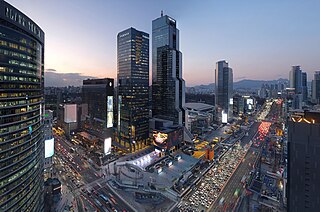
Gangnam District is one of the 25 districts of Seoul, South Korea. The term Gangnam translates to "South of the [Han] River". Gangnam District is the third largest district in Seoul, with an area of 39.5 km2 (15.3 sq mi). As of the 2017 census, Gangnam District had a population of 561,052. There is a high concentration of wealth in the district, with prices for an apartment as of 2020 nearly double those in the rest of Seoul. Gangnam District is part of Gangnam School District Eight, along with the Seocho District. This district shares half of Gangnam-daero Gangnam Station area with Seocho District, which is one of the most crowded places in South Korea.

Songpa District is a district of Seoul, South Korea. Previously known as Wiryeseong, the first capital of the ancient kingdom of Baekje, Songpa is located in the southeastern part of Seoul. With roughly 647,000 residents, Songpa is also the largest district in Seoul by population.

Jayang station is a metro station on Seoul Subway Line 7. It is located in Jayang-dong in the Gwangjin-gu administrative district of Seoul. It is the only station in South Korea to be located on the underside of a bridge, beneath Cheongdam Bridge. The station also runs underneath a highway with two exits being south of the highway and two north. The south exits serve Ttukseom Hangang Park, while the north exits serve Jayang 3-dong and Jayang 4-dong which contain some residential towers with small shops and other mixed commercial and residential areas. The station is serviced by a single bus route which is located at exit 4. Before Line 7 opened the station was known as Jayang Station (자양역).

Sejong or Sejong City, officially the Sejong Special Self-Governing City, is a special self-governing city and the de facto administrative capital of South Korea.
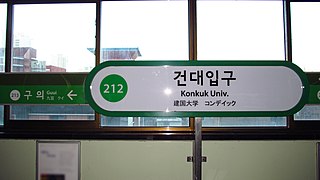
Konkuk University Station is a rapid transit station on Seoul Subway Line 2 and Seoul Subway Line 7. It is located in Hwayang-dong in the Gwangjin-gu administrative district of Seoul. It is adjacent to Konkuk University from which it takes its name. Line 2 is serviced by an elevated platform while Line 7 is serviced by an underground platform. The station has connections to ten bus lines through its six exits as well as a connection to the airport shuttle bus. The station services Hwayang-dong as well as Jayang-dong and Noyu-dong. The area around the station is mixed residential and small commercial businesses. Exits from the underground Line 7 platform open into Konkuk University and the adjacent Star City shopping and high-rise residential tower complex.

Incheon Subway Line 2 is a driverless, medium-capacity subway line running 29.2 km (18.1 mi) from Oryu-dong in Seo-gu to Incheon Grand Park, with 27 stations, part of the Incheon Subway system. The line is also included as a part of the overall Seoul Metropolitan Subway network; Juan station has a free transfer with Seoul Subway Line 1, Geomam station connects with the AREX Line to Incheon International Airport and Seoul Station, and Seongnam also has a free transfer with Seoul Subway Line 7.

Hangang Park (Korean: 한강공원) is a park that consists of 12 parks in Seoul, South Korea. It consists of Gwangnaru Park, Jamsil Park, Ttukseom Park, Jamwon Park, Ichon Park, Banpo Park, Mangwon Park, Yeouido Park, Nanji Park, Gangseo Park, Yanghwa Park, and Seonyudo Park.
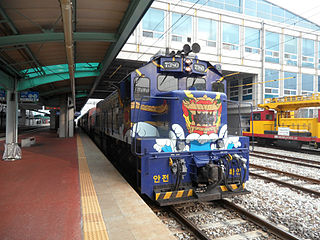
S-Train is a South Korean tourist train operated by Korail. The train began operations in 2013 and transports tourists through southern South Korea.

The Seoul Lantern Festival is a festival held every winter in Seoul in South Korea. It includes lanterns, outdoor light installations, christmas market, experience programs.
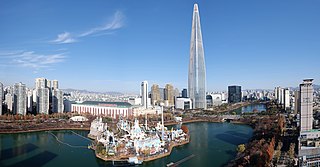
Seokchon Lake Park (Korean: 석촌호수공원) in Songpa District, Seoul, South Korea includes Seokchon Lake and Lotte World's Magic Island. The lake's area is 217,850 m2 (2,344,900 sq ft) and its average depth is about 4.5 meters (15 ft).
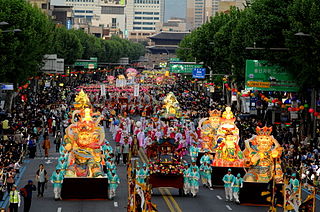
Yeondeunghoe is a lantern-lighting festival in Korea celebrating the Buddha's Birthday. The date of the celebration is marked on the Korean Lunar calendar as the eighth day of the fourth lunar month. The English translation of the name of the festival is written as Yeondeunghoe, Yeon Deung Hoe, or Yeondeung Hoe. Likewise, the exact English translation of the words, “Yeon” “Deung” “Hoe” are varied with suggested meanings as, “Lotus Lantern Festival” and “lighting a lantern.”
























